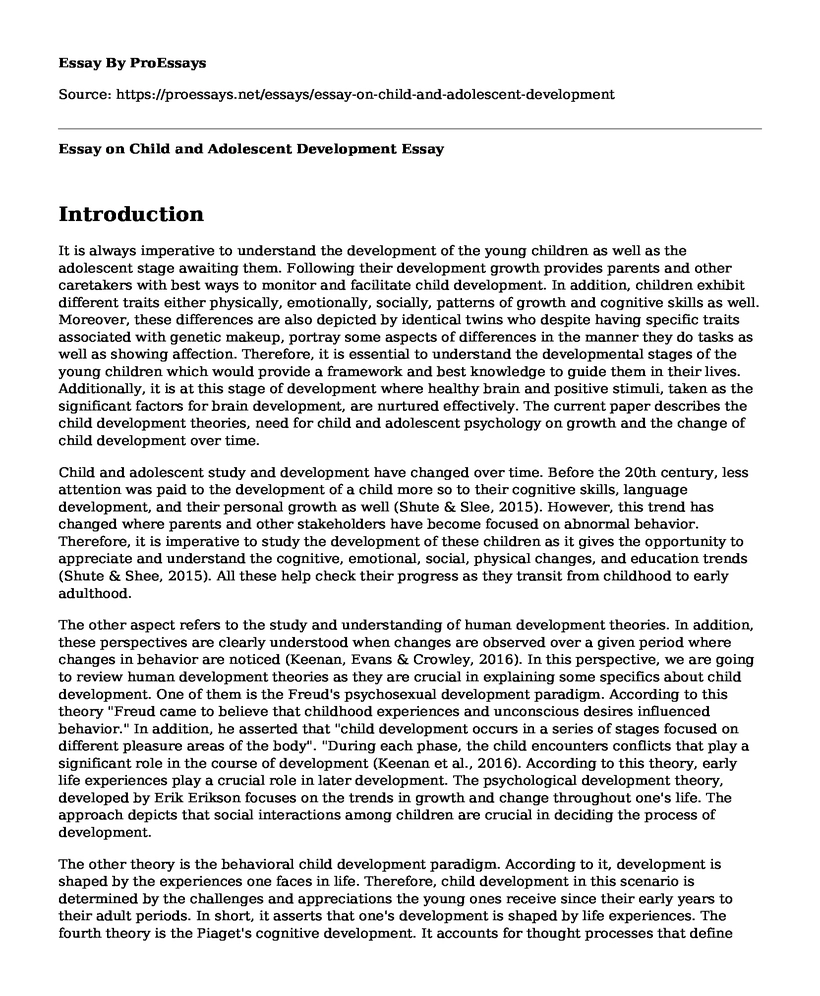Introduction
It is always imperative to understand the development of the young children as well as the adolescent stage awaiting them. Following their development growth provides parents and other caretakers with best ways to monitor and facilitate child development. In addition, children exhibit different traits either physically, emotionally, socially, patterns of growth and cognitive skills as well. Moreover, these differences are also depicted by identical twins who despite having specific traits associated with genetic makeup, portray some aspects of differences in the manner they do tasks as well as showing affection. Therefore, it is essential to understand the developmental stages of the young children which would provide a framework and best knowledge to guide them in their lives. Additionally, it is at this stage of development where healthy brain and positive stimuli, taken as the significant factors for brain development, are nurtured effectively. The current paper describes the child development theories, need for child and adolescent psychology on growth and the change of child development over time.
Child and adolescent study and development have changed over time. Before the 20th century, less attention was paid to the development of a child more so to their cognitive skills, language development, and their personal growth as well (Shute & Slee, 2015). However, this trend has changed where parents and other stakeholders have become focused on abnormal behavior. Therefore, it is imperative to study the development of these children as it gives the opportunity to appreciate and understand the cognitive, emotional, social, physical changes, and education trends (Shute & Shee, 2015). All these help check their progress as they transit from childhood to early adulthood.
The other aspect refers to the study and understanding of human development theories. In addition, these perspectives are clearly understood when changes are observed over a given period where changes in behavior are noticed (Keenan, Evans & Crowley, 2016). In this perspective, we are going to review human development theories as they are crucial in explaining some specifics about child development. One of them is the Freud's psychosexual development paradigm. According to this theory "Freud came to believe that childhood experiences and unconscious desires influenced behavior." In addition, he asserted that "child development occurs in a series of stages focused on different pleasure areas of the body". "During each phase, the child encounters conflicts that play a significant role in the course of development (Keenan et al., 2016). According to this theory, early life experiences play a crucial role in later development. The psychological development theory, developed by Erik Erikson focuses on the trends in growth and change throughout one's life. The approach depicts that social interactions among children are crucial in deciding the process of development.
The other theory is the behavioral child development paradigm. According to it, development is shaped by the experiences one faces in life. Therefore, child development in this scenario is determined by the challenges and appreciations the young ones receive since their early years to their adult periods. In short, it asserts that one's development is shaped by life experiences. The fourth theory is the Piaget's cognitive development. It accounts for thought processes that define how humans relate with the world. The theorist developed a series of cognitive stages that children undergo in their intellectual development. The steps are classified to as; sensorimotor, preoperational, concrete operational, and formal operational stage. All these have a year characteristic and the behavior associated with each. The fifth development theory is the Bowlby's attachment which describes that infants are "born with an innate to form attachments (Keenan et al., 2016)." The resulting factor is that children feel protected after receiving social, emotional, and physical attachments from the bonds they form. It helps them develop a secure attachment style.
Conclusion
All in all, child development is an aspect that has become a crucial issue in the modern society. As discussed above it is imperative to understand the process of child development to guide them in their growth patterns. Development theories are crucial in explaining all these trends.
References
Shute, R. H., & Slee, P. T. (2015). Child development: Theories and critical perspectives. Routledge.
Keenan, T., Evans, S., & Crowley, K. (2016). An introduction to child development. Sage.
Cite this page
Essay on Child and Adolescent Development. (2022, Jun 08). Retrieved from https://proessays.net/essays/essay-on-child-and-adolescent-development
If you are the original author of this essay and no longer wish to have it published on the ProEssays website, please click below to request its removal:
- Summary of the Article: Impact of Gratitude of Resource Development and Emotional Well-being
- Life is About Perseverance - Creative Writing Example
- Teaching and Assessing Language Arts Essay
- The Partnership of AFL and La Trobe University - Paper Example
- How My Mother's Behavior Inspired Me - Essay Sample
- Teacher Evaluation: Systematic Process for Professional Growth - Essay Sample
- Essay on Social Media Normalizing Hate: Balancing Freedom and Responsibility







